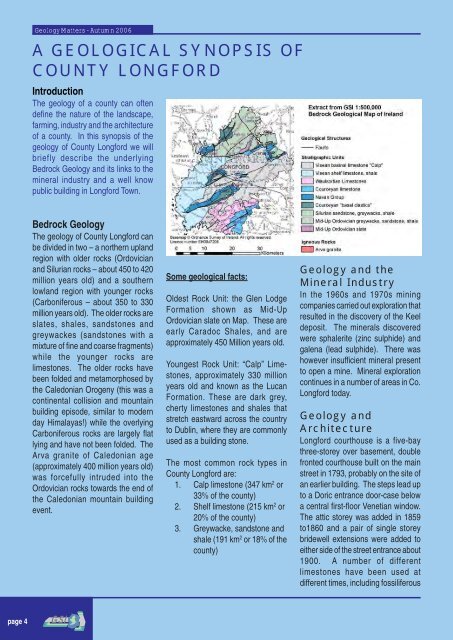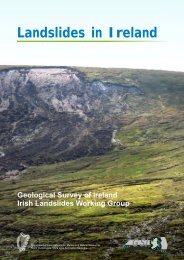Download - Geological Survey of Ireland
Download - Geological Survey of Ireland
Download - Geological Survey of Ireland
You also want an ePaper? Increase the reach of your titles
YUMPU automatically turns print PDFs into web optimized ePapers that Google loves.
Geology Matters - Autumn 2006<br />
A GEOLOGICAL SYNOPSIS OF<br />
COUNTY LONGFORD<br />
Introduction<br />
The geology <strong>of</strong> a county can <strong>of</strong>ten<br />
define the nature <strong>of</strong> the landscape,<br />
farming, industry and the architecture<br />
<strong>of</strong> a county. In this synopsis <strong>of</strong> the<br />
geology <strong>of</strong> County Longford we will<br />
briefly describe the underlying<br />
Bedrock Geology and its links to the<br />
mineral industry and a well know<br />
public building in Longford Town.<br />
Bedrock Geology<br />
The geology <strong>of</strong> County Longford can<br />
be divided in two – a northern upland<br />
region with older rocks (Ordovician<br />
and Silurian rocks – about 450 to 420<br />
million years old) and a southern<br />
lowland region with younger rocks<br />
(Carboniferous – about 350 to 330<br />
million years old). The older rocks are<br />
slates, shales, sandstones and<br />
greywackes (sandstones with a<br />
mixture <strong>of</strong> fine and coarse fragments)<br />
while the younger rocks are<br />
limestones. The older rocks have<br />
been folded and metamorphosed by<br />
the Caledonian Orogeny (this was a<br />
continental collision and mountain<br />
building episode, similar to modern<br />
day Himalayas!) while the overlying<br />
Carboniferous rocks are largely flat<br />
lying and have not been folded. The<br />
Arva granite <strong>of</strong> Caledonian age<br />
(approximately 400 million years old)<br />
was forcefully intruded into the<br />
Ordovician rocks towards the end <strong>of</strong><br />
the Caledonian mountain building<br />
event.<br />
Some geological facts:<br />
Oldest Rock Unit: the Glen Lodge<br />
Formation shown as Mid-Up<br />
Ordovician slate on Map. These are<br />
early Caradoc Shales, and are<br />
approximately 450 Million years old.<br />
Youngest Rock Unit: “Calp” Limestones,<br />
approximately 330 million<br />
years old and known as the Lucan<br />
Formation. These are dark grey,<br />
cherty limestones and shales that<br />
stretch eastward across the country<br />
to Dublin, where they are commonly<br />
used as a building stone.<br />
The most common rock types in<br />
County Longford are:<br />
1. Calp limestone (347 km 2 or<br />
33% <strong>of</strong> the county)<br />
2. Shelf limestone (215 km 2 or<br />
20% <strong>of</strong> the county)<br />
3. Greywacke, sandstone and<br />
shale (191 km 2 or 18% <strong>of</strong> the<br />
county)<br />
Geology and the<br />
Mineral Industry<br />
In the 1960s and 1970s mining<br />
companies carried out exploration that<br />
resulted in the discovery <strong>of</strong> the Keel<br />
deposit. The minerals discovered<br />
were sphalerite (zinc sulphide) and<br />
galena (lead sulphide). There was<br />
however insufficient mineral present<br />
to open a mine. Mineral exploration<br />
continues in a number <strong>of</strong> areas in Co.<br />
Longford today.<br />
Geology and<br />
Architecture<br />
Longford courthouse is a five-bay<br />
three-storey over basement, double<br />
fronted courthouse built on the main<br />
street in 1793, probably on the site <strong>of</strong><br />
an earlier building. The steps lead up<br />
to a Doric entrance door-case below<br />
a central first-floor Venetian window.<br />
The attic storey was added in 1859<br />
to1860 and a pair <strong>of</strong> single storey<br />
bridewell extensions were added to<br />
either side <strong>of</strong> the street entrance about<br />
1900. A number <strong>of</strong> different<br />
limestones have been used at<br />
different times, including fossiliferous<br />
page 4

















